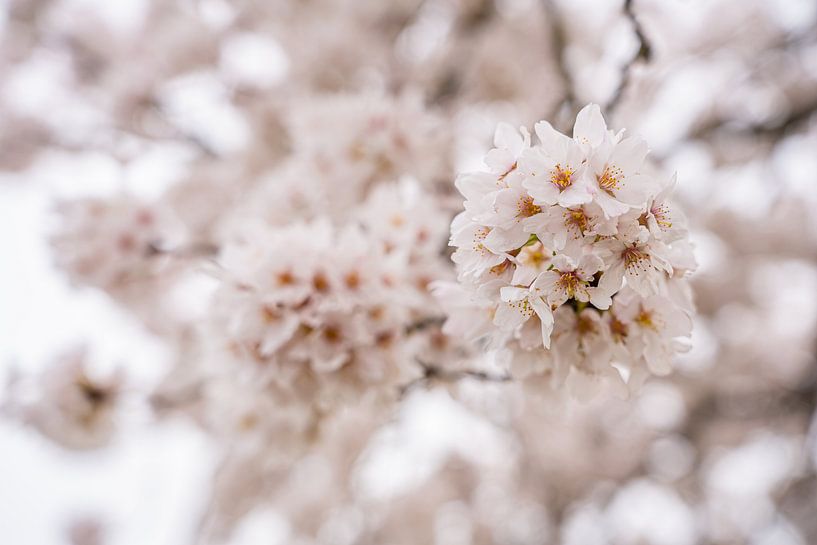Buy the photo Cherry blossom on a cloudy day by Jeroen de Jongh Photography on canvas, ArtFrame, poster and wallpaper, printed on demand in high quality.
About "Cherry blossom on a cloudy day"
by Jeroen de Jongh Photography
About the artwork
Cherry blossoms, also called sakura in Japan, are the flowers of several trees of the genus Prunus, especially the Japanese cherry, Prunus serrulata. They are celebrated for their ephemeral beauty, symbolising the transience of life, renewal and the arrival of spring.
Cherry blossoms have deep cultural significance, especially in Japanese culture. They represent the ephemeral nature of life, beauty, renewal and the fleeting nature of existence. They are often associated with themes of mortality and appreciation of the present moment.
Cherry blossoms usually bloom in spring, usually between March and May, depending on the region and the specific variety of cherry trees. Their flowering period is short-lived and usually lasts only a few weeks, making them a long-awaited event.
In Japan, the tradition of hanami, or looking at cherry blossoms, is an ancient custom where people come together to appreciate the beauty of cherry blossoms. This tradition consists of picnicking under cherry blossom trees, enjoying food and drinks with friends and family while admiring the flowers.
Cherry blossoms are often depicted in art, literature and various media forms as symbols of beauty, renewal and the impermanence of life. They are also often used in traditional Japanese patterns and motifs.
Overall, cherry blossoms are not just beautiful flowers; they have a deep cultural and symbolic meaning that transcends borders and resonates with people around the world.

About Jeroen de Jongh Photography
I'm Jeroen, and I'll spare you the long introduction. ;) If you're looking for a landscape photo for your wall, you've come to the right place... Read more…
 Netherlands
Netherlands Ordered in February 2019
Ordered in February 2019
 Netherlands
Netherlands Ordered in March 2020
Ordered in March 2020
 Netherlands
Netherlands Ordered in December 2024
Ordered in December 2024
 Germany
Germany Ordered in April 2019
Ordered in April 2019
 Germany
Germany Ordered in November 2020
Ordered in November 2020
 Netherlands
Netherlands Ordered in October 2024
Ordered in October 2024
 Netherlands
Netherlands Ordered in March 2019
Ordered in March 2019
 Netherlands
Netherlands Ordered in March 2024
Ordered in March 2024
 Netherlands
Netherlands Ordered in December 2017
Ordered in December 2017
 Netherlands
Netherlands Ordered in November 2023
Ordered in November 2023
 Netherlands
Netherlands Ordered in June 2021
Ordered in June 2021

 Germany
Germany Ordered in March 2021
Ordered in March 2021
About the material
ArtFrame™
Interchangeable Art Prints
- High-quality print
- Easily interchangeable
- Acoustic function
- Large sizes available
Discover the artworks of Jeroen de Jongh Photography
 Full moon at the flower marketJeroen de Jongh Photography
Full moon at the flower marketJeroen de Jongh Photography Lange HavenJeroen de Jongh Photography
Lange HavenJeroen de Jongh Photography Scheveningen PierJeroen de Jongh Photography
Scheveningen PierJeroen de Jongh Photography Lighthouse StavorenJeroen de Jongh Photography
Lighthouse StavorenJeroen de Jongh Photography April 25th BridgeJeroen de Jongh Photography
April 25th BridgeJeroen de Jongh Photography OosterdokJeroen de Jongh Photography
OosterdokJeroen de Jongh Photography Climb to the lightJeroen de Jongh Photography
Climb to the lightJeroen de Jongh Photography MonnickendamJeroen de Jongh Photography
MonnickendamJeroen de Jongh Photography Zonnepad MonnickendamJeroen de Jongh Photography
Zonnepad MonnickendamJeroen de Jongh Photography Mill de Vlinder on a misty morning in the BetuweJeroen de Jongh Photography
Mill de Vlinder on a misty morning in the BetuweJeroen de Jongh Photography Town Hall of Gouda at the MarketJeroen de Jongh Photography
Town Hall of Gouda at the MarketJeroen de Jongh Photography Swans at the skyline of ZutphenJeroen de Jongh Photography
Swans at the skyline of ZutphenJeroen de Jongh Photography Quiet autumn morning in the park of Groeneveld CastleJeroen de Jongh Photography
Quiet autumn morning in the park of Groeneveld CastleJeroen de Jongh Photography Magical sunrise at the Amstelveense PoelJeroen de Jongh Photography
Magical sunrise at the Amstelveense PoelJeroen de Jongh Photography Sunrise in the cherry blossom park of the Amsterdamse BosJeroen de Jongh Photography
Sunrise in the cherry blossom park of the Amsterdamse BosJeroen de Jongh Photography The last autumn sunlight on Mill 't HaantjeJeroen de Jongh Photography
The last autumn sunlight on Mill 't HaantjeJeroen de Jongh Photography Peace and quiet at Schiedam's Lange HavenJeroen de Jongh Photography
Peace and quiet at Schiedam's Lange HavenJeroen de Jongh Photography Tram 47 passes over the Freedom Bridge in BudapestJeroen de Jongh Photography
Tram 47 passes over the Freedom Bridge in BudapestJeroen de Jongh Photography Rapeseed at sunrise in Werk aan de GroenewegJeroen de Jongh Photography
Rapeseed at sunrise in Werk aan de GroenewegJeroen de Jongh Photography Sunset at the Tower of Ransdorp in AmsterdamJeroen de Jongh Photography
Sunset at the Tower of Ransdorp in AmsterdamJeroen de Jongh Photography













 Amsterdam
Amsterdam Blossom
Blossom Bokeh
Bokeh Europe
Europe Gentle Whispers
Gentle Whispers Nature and weather
Nature and weather North Holland
North Holland Photo wallpaper
Photo wallpaper Photography
Photography Serene Peace
Serene Peace The Netherlands
The Netherlands Trees
Trees









